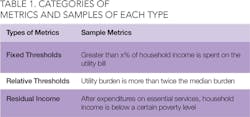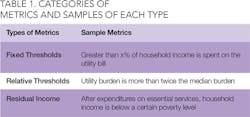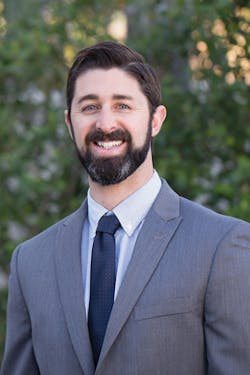Affordability: Lessons Learned from Gas and Electric Utilities
By Katie Cromwell, Kevin Kostiuk, and Henrietta Locklear
What can the water industry learn from others as affordability issues grow in prominence? The third article in this four-part series describes lessons learned from the energy industry’s experiences with affordability and culled from recent national discussions on water affordability.
One of the remarkable observations found from examining the energy utility industry and its history with affordability is that even with national awareness and federal funding and policies to address the issue, efforts fall far short of the need.1 The energy sector began implementing affordability programs 40 years ago, yet many energy customers continue to struggle with paying their bills and the available funding does not reach far enough. This should not discourage leaders in the water industry; rather it should provide a measure of comfort when progress seems sluggish.
=> Read Part 1: Affordability Meets Sustainability
=> Read Part 2: Affordability in Other Industries
In fact, the organic growth of public policy around affordability programs and testing of ideas in local, individually-crafted programs may result in a more comprehensive and effective approach to the development of industry standards for water affordability. Local utilities can function like laboratories for effective solutions, the same way that states have been the incubators for successful national policy.2 Focused national attention on the issue of affordability or a large infusion of funding would be welcome but could short circuit the fruitful work that individual utilities and industry leaders are completing to relieve the burden of water service on low-income customers.
Selecting Thresholds and Metrics to Assess Affordability
A series of papers by the Centre on Regulation in Europe cites the energy industry as being the most advanced on affordability metrics among the energy, water, telecom, and transport industries.3 Thus, the industry provides models, both positive and negative, for the water utility industry. A compilation of metrics from both European Union standards and from the U.S. show that three major categories of measures are used to assess customer affordability: fixed thresholds, relative thresholds, and residual income — each of which has its advantages and disadvantages.
One of the conclusions from the series of papers reinforces a criticism levied at the prevalent “2 percent of median household income (MHI) standard” used to measure water affordability in the U.S. That is, the pursuit of the wrong metrics can lead to policies and programs that are ineffective and inefficient and do not reach customers who need it the most.4 While the metrics that are most criticized are used in some energy affordability programs, there are a variety of successful programs that use other metrics that can provide a roadmap for the water utility industry to implement effective policies.
Rates: Neither the Villain nor the Hero
Within the water industry, particularly in communities and regions suffering a crisis of affordability, there is a nearly singular focus on using water and sewer rate structures to achieve affordable outcomes for low-income, disadvantaged, and fixed-income customers. And in certain states (as discussed in previous articles in this series), the prohibition of rate revenue for affordability programs drives managers to fixate on rates as the sole tool for achieving affordable service. However, less focus on rates and customer bills and more focus on direct assistance to households and local communities in need would be more beneficial.
According to water affordability expert Manny Teodoro of Texas A&M University, water bills are not the only problem for the customers the utility is attempting to help. Water and sewer service is just one component in the grand scheme of household budgets where the combination of housing, healthcare, and other costs leads to an unsustainable situation. Instead of focusing on the rates and rate structure that dictate the water and/or sewer bill, focus should be given to providing direct assistance to those who need it most through direct payments, retrofits, leak repairs, and efficiency upgrades. While careful rate design can aid customer affordability, rates are not the only tool for solving an affordability crisis.5
Use Best Practices to Build Effective Programs
A recent paper by the Water Research Foundation identified lessons learned from other industries that are applicable to water and sewer customer assistance programs (CAPs).6 These industries include energy, healthcare, and education. Broadly, the four main lessons that cut across all industries are:
1. Identify and understand the group(s) that you are targeting. Without a base of knowledge and a target group, a utility must rely on a general campaign/outreach, which has proven less effective in assisting those most in need and maximizing enrollment.7
2. Building trust within the target groups is imperative for success, and this is best achieved by partnering with community-based organizations (CBOs) that work across many issues affecting low-income and disadvantaged communities.
3. Go to those in need, do not make them come to you. Partner with CBOs and other outside groups to contact the target groups simultaneously as they are being targeted for other CAPs. One-on-one application assistance is essential to enrollment as it helps people with language barriers, technology barriers, health issues, etc. A recent example of this strategy was during Affordable Care Act (ACA) enrollment or peer-to-peer outreach in the Federal Head Start program where parents of enrollees become ambassadors for the program.
4. Commit long-term resources including funding and staffing. Anecdotal evidence from the Australian health services8 illustrates pitfalls of short-term funding sources, including disrupting program processes and relationships, perceived broken promises (referred to as “initiative fatigue”), lack of enthusiasm, and staff turnover.
Another study on energy programs contains recommendations that align with best practices that water utility affordability program leaders have already recognized. For example, the study recommends that organizations share data and cooperatively serve vulnerable populations to facilitate participation in available programs across utilities. 9 From energy, an example was Bay Area Regional Energy Network (BayREN), which markets through local governments to reach customers more effectively. An example from a recent water affordability panel demonstrated the benefits of information sharing between state social services departments and water utilities. Some water utilities have recognized that they can decrease the cost of program administration by aligning eligibility criteria for their programs with those of existing programs or even automatically enrolling customers who are enrolled in a sister program. Leaders also recommended a simple approach to program eligibility such as qualifying all customers that are less than 200 percent of very low income (VLI).10
Varying Restrictions on Using Rate Revenues to Fund Assistance Programs
In the case of energy utilities, it appears that many state public utility commissions (PUCs) walk a line and use their discretion on the level of authority they have to mandate that rate affordability programs be implemented. In the absence of statutory mandates, PUC interpretation and mandates may lead to adjudication in the courts, or in the case of Pennsylvania’s CAP, can lead to a program being codified in statute.
Other examples include the Public Utility Commission of Ohio’s (PUCO) Percent of Income Payment Plan (PIPP) program, which made it to the State Supreme Court. PUCO prevailed based on emergency powers granted by state code (RC 4909.16). In Colorado in 1979, the State Supreme Court prohibited the Colorado Public Utilities Commission (CPUC) from mandating low-income assistance programs on investor-owned utilities, holding that the CPUC was attempting to make social policy decisions without authority to do so. In future years, the CPUC worked around this decision by making an economic determination of the benefit for assistance programs which provide savings to customers. Low-income assistance has since been written into statute in Colorado (C.R.S. 40-3-106).
As individual water and wastewater utilities consider potential programs and solutions for their customer affordability concerns, it is important that they account for existing local, state, and federal restrictions on these programs.
The Final Installment
As discussed, the energy utility industry and, indeed, other public programs, provide examples and research to guide affordability policy and program development in the water utility industry. Selecting a model for national policy, selecting effective affordability metrics, choosing which areas are most effective for program focus, reaching customers to facilitate participation, and navigating state restrictions on customer assistance program are all areas in which lessons can be learned. In the fourth and final article in our series, we will discuss the ways that energy affordability lessons and models fit into the future of water affordability. WW
=>Read Part 4: The Future of Water Affordability Programs
About the Authors:
Katie Cromwell is a senior consultant with Raftelis in its Cary, N.C. office. With a background in environmental regulation, permitting and compliance as well as financial management, she has worked extensively with water, wastewater, and stormwater utilities on implementing funding strategies including the analysis and visualization of affordability within communities.
Kevin Kostiuk is a senior consultant with Raftelis in its Los Angeles, Calif., office. His background is in economics and accounting and his areas of expertise include financial accounting, environmental policy, water supply and flood control policy and operations. In addition, he has worked extensively in innovative rate design in response to emerging issues such as drought and affordability concerns.
Henrietta Locklear is a senior manager with Raftelis and leads its Memphis, Tenn., office. Her background is in local government management including environmental finance and public policy. Her work includes assessing and implementing affordability programs for large utilities. She leads the Raftelis affordability community of practice, a group of practitioners within the company engaged in leadership on affordability issues in the utility industry.
References
1. According to HHS, 7.4 million households received heating or winter crisis assistance and approximately 900,000 households received cooling assistance in that year. (LIHEAP: Program and Funding by Congressional Research Service. July 2013)
2. States as “laboratories of democracy” introduced in Justice Brandeis’ opinion found in the 1932 Supreme Court case New State Ice Co. v. Liebmann, 284 U.S. 262. Found at: https://supreme.justia.com/cases/federal/us/285/262/ Accessed July 17, 2018
3. Drebohl, Ariel and Lauren Ross, American Council for an Energy Efficient Economy. The US Low-Income Energy Affordability Landscape: Alleviating High Energy Burden with Energy Efficiency in Low-Income Communities. https://aceee.org/files/proceedings/2016/data/papers/11_326.pdf. Accessed July 17, 2018.
4. Series abstract: http://www.cerre.eu/publications/affordability-utilities%E2%80%99-services-extent-practice-policy, accessed July 18, 2018, and criticism of the affordability standard found in Teodoro, Manuel. Measuring Household Affordability for Water and Sewer Utilities. Journal AWWA, January 2018. 110.1. http://mannyteodoro.com/wp-content/uploads/2014/03/Teodoro-JAWWA-2018-affordability-methology.pdf. Accessed July 19, 2018.
5. State Water Resources Control Board (SWRCB)’s Water Affordability Symposium, Sacramento, CA, April 5, 2018. Webcast archive: http://cal-span.org/unipage/index.php?site=cal-span&owner=SWRCB&date=2018-04-05; Accessed July 18, 2018.
6. Water Research Foundation. Customer Assistance Programs for Multi-Family Residential and Other Hard-to-Reach Customers Project #4557, 2017. Accessed July 9, 2018.
7. Hipps, J. and D. Hungerford. Communicating Messages to Hard-to-Reach Consumers: Lessons from the Electric Education Trust. 2004. http://aceee.org/files/proceedings/2004/data/papers/SS04_Panel7_Paper10.pdf. Accessed July 13, 2018.
8. Occasional Paper No. 26: Engaging hard-to-reach families and children. Department of Families, Housing, Community Services and Indigenous Affairs, 2009. https://www.dss.gov.au/sites/default/files/documents/op26.pdf. Accessed July 17, 2018.
9. Drebohl, A. “The US Low-Income Energy Affordability Landscape.”
10. SWRCB Water Affordability Symposium.
Circle No. 310 on Reader Service Card





